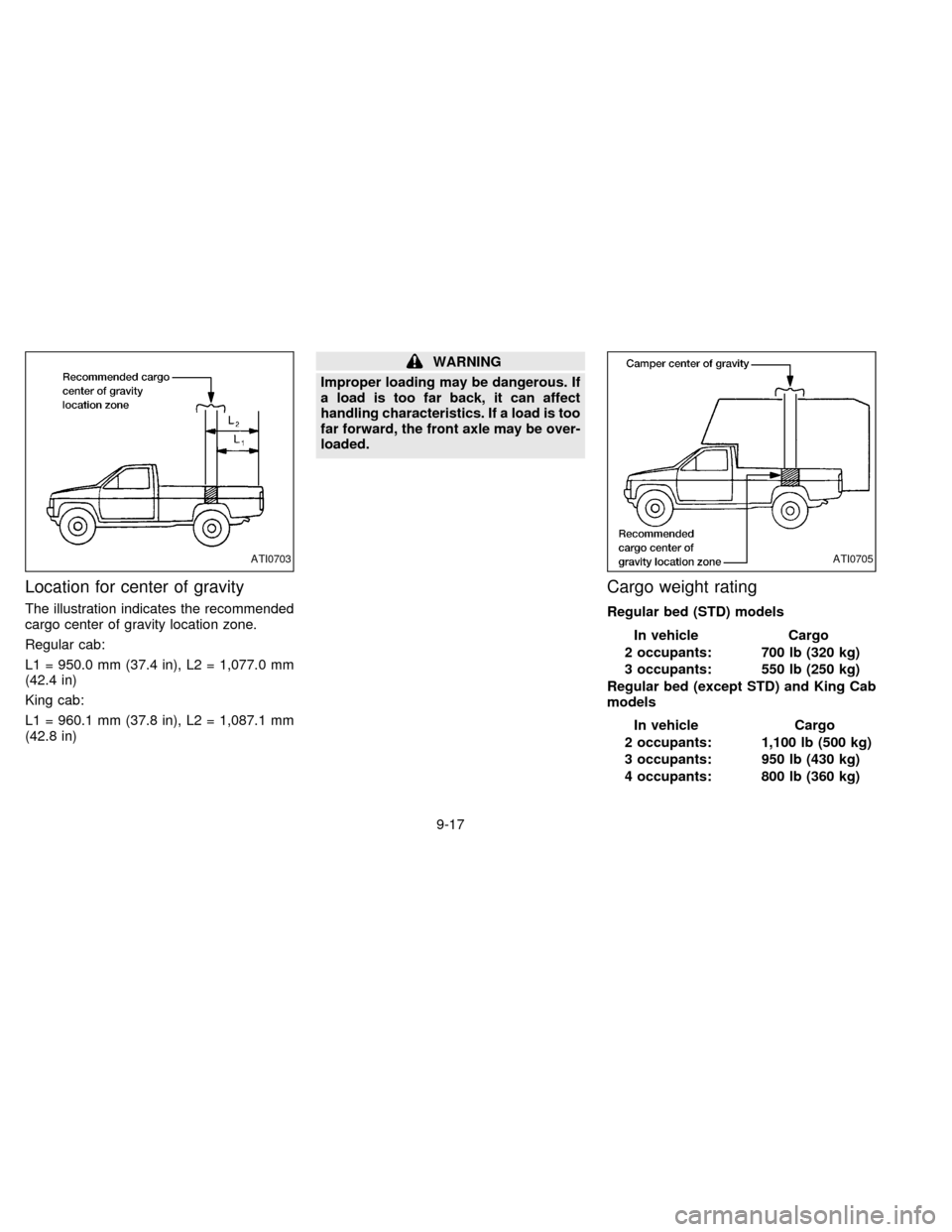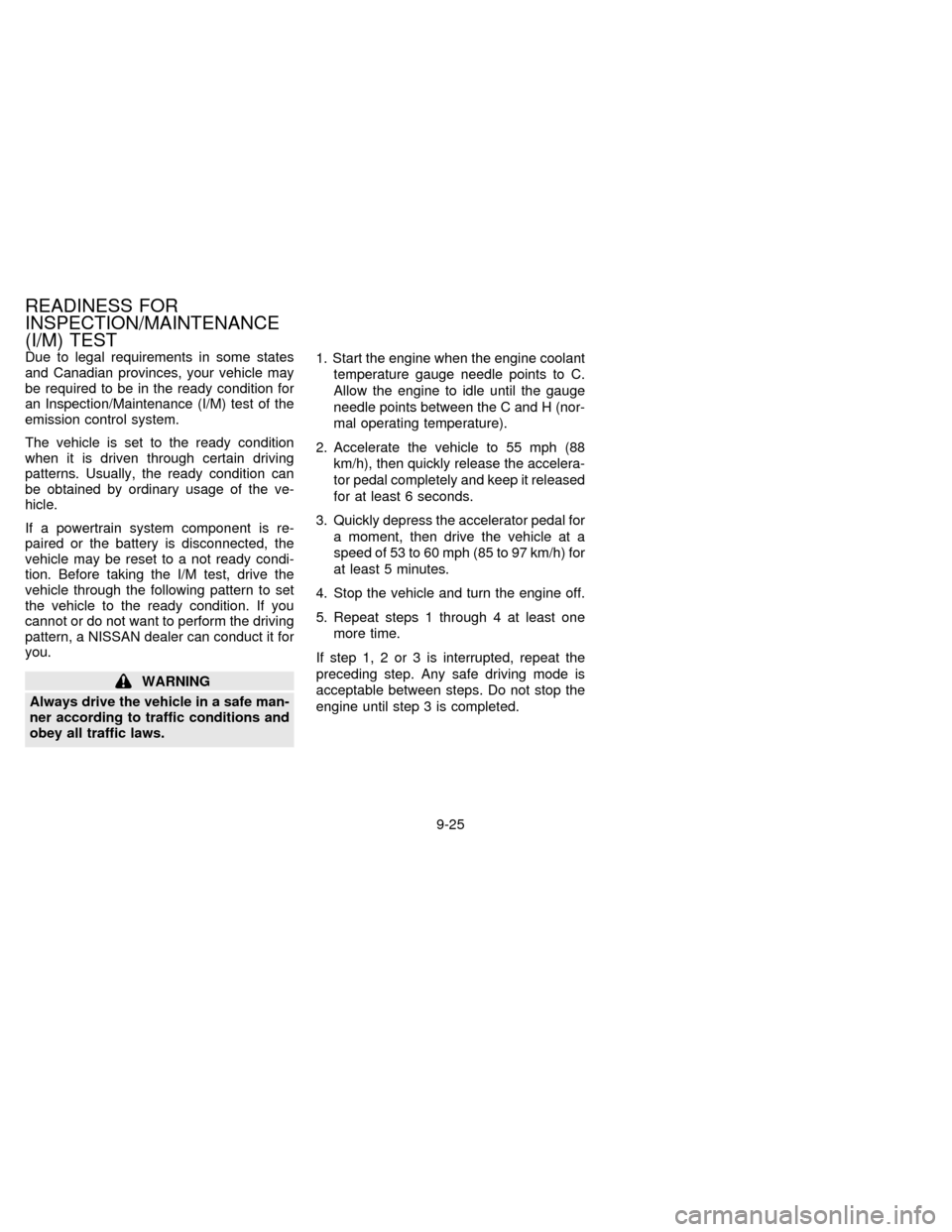1997 NISSAN FRONTIER ECO mode
[x] Cancel search: ECO modePage 187 of 204

SECURING THE LOAD
For your convenience, tie down hooks are
placed at each corner of the truck box.
These may be used to help secure cargo
loaded into the truck box.
WARNING
cProperly secure all cargo with ropes
or straps to help prevent it from
sliding or shifting. In a sudden stop
or collision, unsecured cargo could
cause personal injury.cDo not place cargo higher than the
seatbacks. In a sudden stop or colli-
sion, unsecured cargo could cause
personal injury.
cDo not load your vehicle any heavier
than the GVWR or the maximum
front and rear GAWR's. If you do,
parts on your vehicle can break, or it
can change the way your vehicle
handles. This could result in loss of
control and cause personal injury.
CAUTION
Overloading can shorten the life of your
vehicle. Failures caused by overloading
are not covered by your warranty.
This information is provided for you to prop-
erly install a slide-in camper and is based on
the National Highway Traffic Safety Admin-
istration regulations. It is recommended
that, before installing the camper, you care-
fully read the following information and en-
sure that the camper meets the specifica-
tions.
This information may not apply to some
Canada model vehicles.
Special body vehicles
Some vehicles are equipped with commer-
cial or camper bodies. However, this Own-
er's Manual does not cover these options.
For further information, please refer to the
body manufacturer's instruction manual.STI0049
TRUCK-CAMPER LOADING
9-16
ZX
Page 188 of 204

Location for center of gravity
The illustration indicates the recommended
cargo center of gravity location zone.
Regular cab:
L1 = 950.0 mm (37.4 in), L2 = 1,077.0 mm
(42.4 in)
King cab:
L1 = 960.1 mm (37.8 in), L2 = 1,087.1 mm
(42.8 in)
WARNING
Improper loading may be dangerous. If
a load is too far back, it can affect
handling characteristics. If a load is too
far forward, the front axle may be over-
loaded.
Cargo weight rating
Regular bed (STD) models
In vehicle Cargo
2 occupants: 700 lb (320 kg)
3 occupants: 550 lb (250 kg)
Regular bed (except STD) and King Cab
models
In vehicle Cargo
2 occupants: 1,100 lb (500 kg)
3 occupants: 950 lb (430 kg)
4 occupants: 800 lb (360 kg)
ATI0703ATI0705
9-17
ZX
Page 191 of 204

Unit: lb (kg)
MODEL
WEIGHT2WD TRUCK
4WD TRUCK
M/T A/T
MAXIMUM
TRAILER
WEIGHT*13,500 (1,588) 2,000 (907) 3,500 (1,588)
MAXIMUM
TONGUE
LOAD350 (159) 200 (91) 350 (159)
GROSS
COMBINED
WEIGHT
RATING7,000 (3,175) 5,500 (2,495) 7,700 (3,493)
RECOMMENDED
EQUIPMENT*2Sway
Control
Device (SCD)ÐSway
Control
Device (SCD)
*1: All towing above 1,000 lb (454 kg) requires the use of trailer brakes. NISSAN recommends the use of a tandem axle trailer whenever towing above 3,000
lb (1,361 kg).
*2: A sway control device is recommended for all towing above 2,000 lb (907 kg). Sway control devices are not offered by NISSAN. See a professional
trailer/hitch outlet for a properly designed sway control device for your trailer.
M/T = Manual Transmission
A/T = Automatic Transmission
2WD = 2-wheel drive
4WD = 4-wheel drive
TOWING LOAD/
SPECIFICATION CHART
9-20
ZX
Page 193 of 204

prevent load shifts while driving.
cBe certain your outside mirrors conform
to all federal, state or local regulations. If
not, install any mirrors required for towing
before driving the vehicle.
Trailer towing tips
In order to gain skill and an understanding
of the vehicle's behavior, you should prac-
tice turning, stopping and backing up in an
area which is free from traffic. Steering,
stability and braking performance will be
somewhat different than under normal driv-
ing conditions.
cAlways secure items in the trailer to
prevent load shift while driving.
c
Avoid abrupt starts, acceleration or stops.
cAvoid sharp turns or lane changes.
cAlways drive your vehicle at a moderate
speed.
cAlways block the wheels on both vehicle
and trailer when parking. Parking on a
slope is not recommended; however, if
you must do so, and if your vehicle is
equipped with automatic transmission,
first block the wheels and apply the park-ing brake, and then move the transmis-
sion shift lever into the P position. If you
move the shift lever to the P position
before blocking the wheels and applying
the parking brake, transmission damage
could occur.
cWhen going down a hill, shift into a lower
gear and use the engine braking effect.
When ascending a long grade, downshift
the transmission to a lower gear and
reduce speed to reduce chances of en-
gine overloading and/or overheating.
However, for long steep grades, do not
stay in 1st or 2nd gear when driving
above 35 MPH (56 km/h).
cIf the engine coolant rises to an ex-
tremely high temperature when the air
conditioning system is on, turn off the air
conditioner. Coolant heat can be addi-
tionally vented by opening the windows,
switching the fan control to high and
setting the temperature control to the
HOT position.
cTrailer towing requires more fuel than
normal circumstances.
cAvoid towing a trailer for your vehicle's
first 500 miles (805 km).cHave your vehicle serviced more often
than at intervals specified in the recom-
mended Maintenance Schedule.
cWhen making a turn, your trailer wheels
will be closer to the inside of the turn than
your vehicle wheels. To compensate for
this, make a larger than normal turning
radius during the turn.
cCrosswinds and rough roads adversely
affect vehicle/trailer handling, possibly
causing vehicle sway. When being
passed by larger vehicles, be prepared
for possible changes in crosswinds that
could affect vehicle handling. If swaying
does occur, firmly grip the steering
wheel, steer straight ahead, and immedi-
ately (but gradually) reduce vehicle
speed. This combination helps to stabi-
lize the vehicle. Never increase speed.
cBe careful when passing other vehicles.
Passing while towing a trailer requires
considerably more distance than normal
passing. Remember the length of the
trailer must also pass the other vehicle
before you can safely change lanes.
cTo maintain engine braking efficiency
and electrical charging performance, do
9-22
ZX
Page 196 of 204

Due to legal requirements in some states
and Canadian provinces, your vehicle may
be required to be in the ready condition for
an Inspection/Maintenance (I/M) test of the
emission control system.
The vehicle is set to the ready condition
when it is driven through certain driving
patterns. Usually, the ready condition can
be obtained by ordinary usage of the ve-
hicle.
If a powertrain system component is re-
paired or the battery is disconnected, the
vehicle may be reset to a not ready condi-
tion. Before taking the I/M test, drive the
vehicle through the following pattern to set
the vehicle to the ready condition. If you
cannot or do not want to perform the driving
pattern, a NISSAN dealer can conduct it for
you.
WARNING
Always drive the vehicle in a safe man-
ner according to traffic conditions and
obey all traffic laws.1. Start the engine when the engine coolant
temperature gauge needle points to C.
Allow the engine to idle until the gauge
needle points between the C and H (nor-
mal operating temperature).
2. Accelerate the vehicle to 55 mph (88
km/h), then quickly release the accelera-
tor pedal completely and keep it released
for at least 6 seconds.
3. Quickly depress the accelerator pedal for
a moment, then drive the vehicle at a
speed of 53 to 60 mph (85 to 97 km/h) for
at least 5 minutes.
4. Stop the vehicle and turn the engine off.
5. Repeat steps 1 through 4 at least one
more time.
If step 1, 2 or 3 is interrupted, repeat the
preceding step. Any safe driving mode is
acceptable between steps. Do not stop the
engine until step 3 is completed.
READINESS FOR
INSPECTION/MAINTENANCE
(I/M) TEST
9-25
ZX
Page 202 of 204

Switch
Automatic power window switch .......... 1-16
Hazard warning flasher switch ............. 1-12
Headlight and turn signal switch .......... 1-10
Ignition switch ......................................... 4-4
Overdrive switch ..................................... 4-8
Windshield wiper and washer
switch .................................................... 1-11
T
Tachometer .................................................. 1-3
Tailgate latch ............................................... 2-5
Three way catalyst....................................... 4-2
Tie down hooks ........................................... 2-7
Tilting steering wheel ................................. 2-29
Tire
Flat tire.................................................... 5-2
Spare tire .............................................. 7-29
Tire chains ............................................ 7-26
Tire placard........................................... 9-14
Tire pressure ........................................ 7-25
Tire rotation .......................................... 7-27
Tires of 4-wheel drive ........................... 7-28
Types of tires ........................................ 7-25
Uniform tire quality grading .................. 9-23
Wheels and tires................................... 7-25
Wheel/tire size ...................................... 9-10
Towing
2-wheel drive models ........................... 5-11
4-wheel drive models ........................... 5-12
Tow truck towing .................................. 5-10Towing load/specification chart ............ 9-20
Trailer towing ........................................ 9-18
Transfer case ............................................. 4-15
Transmission
Automatic transmission fluid (ATF) ........ 7-9
Driving with automatic transmission ....... 4-6
Driving with manual transmission ........... 4-9
Travel (See registering your vehicle in another
country) ...................................................... 9-12
Trip odometer .............................................. 1-3
Truck - camper loading.............................. 9-16
Turn signal switch (See highlight and turn
signal switch) ............................................. 1-10
U
Uniform tire quality grading ....................... 9-23
V
Vanity mirror .............................................. 2-31
Vehicle dimensions and weights ............... 9-11
Vehicle identification number
(chassis number) ....................................... 9-12
Vehicle identification number (VIN)
plate ........................................................... 9-12
Vehicle loading information ....................... 9-15
Vehicle recovery ........................................ 5-13
Ventilators .................................................... 3-2W
Warning
Air bag warning light............................. 2-17
Hazard warning flasher switch ............. 1-12
Warning labels (for SRS) ..................... 2-17
Warning/indicator lights and chimes ...... 1-6
Weights (See dimensions and weights) .... 9-11
Wheels and tires ........................................ 7-25
Wheel/tire size ........................................... 9-10
When traveling or registering your vehicle
in another country ...................................... 9-12
Window washer fluid.................................. 7-12
Windows
Manual windows ................................... 1-15
Opera window....................................... 1-17
Power windows..................................... 1-15
Rear sliding window ............................. 1-16
Windshield wiper and washer switch ........ 1-11
Wiper
Windshield wiper and washer
switch .................................................... 1-11
Wiper blades......................................... 7-17
10-5
ZX